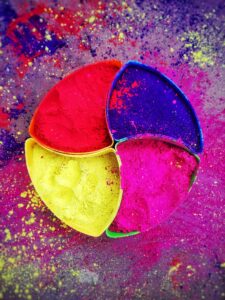Holi-Festival of Colours
When and why is it celebrated?
 The festival of Holi is celebrated annually in March. It is the end of winter and the beginning of spring.
The festival of Holi is celebrated annually in March. It is the end of winter and the beginning of spring.
It’s a two-day Hindu festival celebrated in India and other parts of the world. On the first day, people gather around a bonfire and celebrate good triumphing over evil. On the second day, a perfumed powder called ‘gulal’ is thrown at everyone and made to stick with water pistols and balloons.
Story behind Holi
There are two stories for Holi. Some people believe the Holi colours came from God Krishna mischievously throwing coloured water over his milkmaids (when he was a boy). This developed into the practical jokes and games linked to the festival of Holi.
It is also believed that Prahlad was the son of King Hiranya Kashyap. The king wanted people to worship him and not God. He ordered his son to be killed when he refused to worship him. The king’s evil sister Holika led Prahlad into the flames of a bonfire believing that she had special powers. But Prahlad was saved, and Holika was burned.
What do people eat?
There’s no single set meal for this festival and many people prefer to serve regional vegetarian dishes. In the morning, trays are arranged with snacks such as crisp-fried savoury biscuits and soft lentil dumplings (dhai bhallas). Sweetmeats like gujiyas, jalebis, and pistachio barfi are considered auspicious Holi offerings. Fried pancakes spiced with fennel seeds, make a splendid partner to thickened creamy milk. Chilled thandai and pitchers of lassi are excellent thirst quenchers.
Overall, it is a joyous festival marked by vibrant colours, delicious food and a sense of togetherness among people of all ages and backgrounds.
Article by
Shallu Duggal
English as an additional language Teacher
The Inclusive Learning and Achievement Service (ILAS)
shallu.duggal@northtyneside.gov.uk

